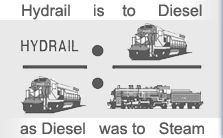 THUNDER BAY – Unless you’re one of the loyal experts who’ve made the six International Hydrail Conferences successful, or live in a town that hydrail stands to enrich, you probably took no notice of the fact that China just entered the hydrail community of nations. Today (29 November, 2010) a joint academic/industrial enterprise announced in the English language People’s Daily that they have “successfully introduced” China’s first “new energy fuel cell light rail [hydrail] locomotive,” potentially moving the country to the head of the hydrail manufacturing and exporting line.
THUNDER BAY – Unless you’re one of the loyal experts who’ve made the six International Hydrail Conferences successful, or live in a town that hydrail stands to enrich, you probably took no notice of the fact that China just entered the hydrail community of nations. Today (29 November, 2010) a joint academic/industrial enterprise announced in the English language People’s Daily that they have “successfully introduced” China’s first “new energy fuel cell light rail [hydrail] locomotive,” potentially moving the country to the head of the hydrail manufacturing and exporting line.
Those of us who follow hydrail—hydrogen fuel cell railroad technology—and give it a shove forward whenever we can, are surprised that China hasn’t stood up to be counted earlier. The enormous Three Gorges hydroelectric project, though environmentally controversial, seemed an ideal source of zero-carbon electrolysis hydrogen for rail propulsion. That could take a big chunk out of the newly car-crazy nation’s huge oil imports and CO2 emissions.
At the same time, the US and Canada (who collaborated years ago in the invention, development and demonstration of hydrail) have got to be wishing they had followed-up in a timely fashion to exploit its enormous job creation potential instead of meekly handing it off to the “shop floor of the world.”
It isn’t as if we couldn’t see it coming. There’s no other realistic alternative to petroleum and track electrification. There’s no need to belabor the need to get off oil (climate, geoilpolitics and all that).
But the dead-end for track electrification needs more explaining. Briefly, copper is a limited resource; the installed cost per mile of overhead power may be US$6 to 8 million and growing; public push-back from aerial plant is on the rise; electric traction power has to be dispatched in real-time, regardless of grid demand; and the labor cost for maintaining a complex superstructure is large and perpetual. When electricity can be carried onboard as hydrogen, why bother with electrification, especially in the wide-open spaces of Canada and the US?
Biofuels are an unlikely option because, however they’re made, they compete with food production for land or other resources and they serve at the will of the weather. As Ontario’s Clean Energy Research Laboratory and the Savannah River National Hydrogen Laboratory in the US bring cheap, mass-produced thermo-chemical hydrogen ever closer, veggie power seems an unlikely long?term solution for strategic heavy transportation.
The US and Canada may still play tortoise to China’s hare for our domestic markets if the will exists. China’s energy and environmental priorities may require that the earliest plants supply their own needs and those of their nearest neighbors for a year or so before the lure of foreign exchange prevails.
Railroads and the manufacturers that supply them are notoriously change?averse for valid reasons. But if the pending paradigm shift in China is heeded soon, they may yet exploit the home?team advantage that shipping costs confer, retaining the domestic hydrail market. But the shipping knife cuts two ways. It costs as much to export rolling stock as to import it. Years of delay may already have not only ceded China as an export market but also lost the larger Indian hydrail market to their next?door neighbor.
Immediate savings don’t drive technology change; societal factors and early adoption do. LED lighting costs perhaps twenty to thirty times more than equivalent incandescent bulbs. But that only effects the speed of the paradigm shift, not its inevitability.
Look how fast the price of compact fluorescents is falling, though they still cost a lot more than tungsten technology. Cathode ray tube TVs went off?shore and pricier flat screen technologies sent them over the hill after black-and-white.
The first hydrail rolling stock, too, will have a lot of R&D expense factored into the price, even with government incentives. But, over the next decade, come it will…cheap if by land, dear if by sea.
Stan Thompson
Stan Thompson is a retired strategic planner and environmental futurist for BellSouth Telecommunications. He is also the Chairman of the Hydrogen Economy Advancement Team (HEAT).
Visit www.hydrail.org for more information.

